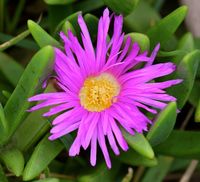Creating Habitat for Local Wildlife in Your Garden...
Bandicoots, echidnas, possums, land mullets, blue-tongues, tree frogs, rocket frogs, tawny frogmouths, blue wrens, honey-eaters... just naming a few of our little mates who are on the look out for good homes. As we all watch the increasing development of our town - this month we’d like to share tips on creating habitat for local wildlife in your garden.
|
1. Create layers and diversity
2. Plant natives local to Lennox
We have many great local native plant species to choose from. When choosing keep in mind that some plants grow better in sandy soils and others in red soils. Here are some local natives which are easy to get your hands on at native nurseries.
Tree Layer: Banksia, Tuckeroo, Brown Kurrajong, Beach Bird’s Eye, Lilly Pilly, Macaranga, Bangalow Palm.
Mid Layer: Cordyline, Native Ginger, Midgen Berry, Walking Stick Palm, Burrawang, Grass Tree.
Ground Layer: Blechnum Fern, Birdsnest, Pigface, Dianella, Native Violet.
3. Look out for locals popping up
With any luck you shouldn’t need to invest in ground layer species. Many of these will simply pop-up in your garden and it’s more about knowing what they are and not pulling them out. Common pop-ups are soft brackens, native violets, commelina and basket grass. Also, if you have a tree that birds are fond of, you’re likely to find a variety of local trees popping up underneath it. Remember that if plants aren’t popping up where you want them to you could always transplant them somewhere more suitable.
4. Explore and learn
The best advice we can give you is to get out and explore our local nature. Walk the headlands, the dunes and the heathlands. Learn about the plants we have and the animals they attract.* This knowledge will empower you to create a haven for both you and the local wildlife to love... so until next month - here's to gettin’ wild in the garden!
*If you need a hand identifying plants we’re always here to help. Take a pic of it and send it to us or post it to our fb page. Native nurseries also offer great advice and there is stacks of info in the ‘Ballina Council Urban Garden Guide’, which you can find online.
- When planning your garden, try to establish layers which mimic what we find in our natural areas - you’ll need a tree layer, mid layer and ground layer.
- Leave some leaf litter and fallen branches - this is habitat for invertebrates and insects, and feeding areas for frogs, lizards, small mammals and ground birds.
- Plant a variety of species which provide a range of foods such as nectar, fruits or berries, and seeds. Also plant species which flower at different times to provide year-round food for wildlife.
- Place rocks, boulders or logs around for lizards and frogs to shelter in.
- Don’t forget wildlife needs water - so putting in a frog pond or bird bath is a good idea.
2. Plant natives local to Lennox
We have many great local native plant species to choose from. When choosing keep in mind that some plants grow better in sandy soils and others in red soils. Here are some local natives which are easy to get your hands on at native nurseries.
Tree Layer: Banksia, Tuckeroo, Brown Kurrajong, Beach Bird’s Eye, Lilly Pilly, Macaranga, Bangalow Palm.
Mid Layer: Cordyline, Native Ginger, Midgen Berry, Walking Stick Palm, Burrawang, Grass Tree.
Ground Layer: Blechnum Fern, Birdsnest, Pigface, Dianella, Native Violet.
3. Look out for locals popping up
With any luck you shouldn’t need to invest in ground layer species. Many of these will simply pop-up in your garden and it’s more about knowing what they are and not pulling them out. Common pop-ups are soft brackens, native violets, commelina and basket grass. Also, if you have a tree that birds are fond of, you’re likely to find a variety of local trees popping up underneath it. Remember that if plants aren’t popping up where you want them to you could always transplant them somewhere more suitable.
4. Explore and learn
The best advice we can give you is to get out and explore our local nature. Walk the headlands, the dunes and the heathlands. Learn about the plants we have and the animals they attract.* This knowledge will empower you to create a haven for both you and the local wildlife to love... so until next month - here's to gettin’ wild in the garden!
*If you need a hand identifying plants we’re always here to help. Take a pic of it and send it to us or post it to our fb page. Native nurseries also offer great advice and there is stacks of info in the ‘Ballina Council Urban Garden Guide’, which you can find online.




